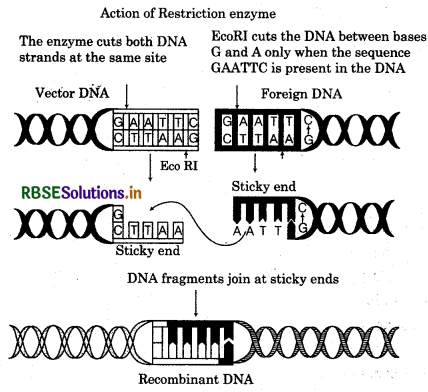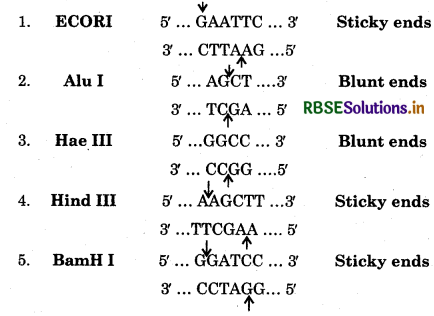RBSE Solutions for Class 12 Biology Chapter 11 Biotechnology: Principles and Processes
Rajasthan Board RBSE Solutions for Class 12 Biology Chapter 11 Biotechnology: Principles and Processes Textbook Exercise Questions and Answers.
RBSE Class 12 Biology Solutions Chapter 11 Biotechnology: Principles and Processes
RBSE Class 12 Biology Biotechnology: Principles and Processes Textbook Questions and Answers
Question 1.
Can you list 18 recombinant proteins which are used in medical practice? Find out where they are used as therapeutics (use the internate)
Answer:
Recombinant proteins are the important part of biotechnology. The first recombinant protein used in treatment was human insulin in 1982.
- Human insulin - Diabetes
- Human growth hormone - Dwarfism cure
- Interferon α - used for chronic hepatitis
- Interferon ß - Herpes and viral enteritis
- Coagulation Factor VII - Haemophilia A
- DNA are I - Cystic fibrosis
- Interlinking - Enhance immune reaction
- PDGF (Platelet derived growth factor) - wound healing.
- Tissue Plasminogen Activator - Acute myocardial infection.
- Herpes Vaccine - Prevention of infectious diseases.

Question 2.
Make a chart (with diagrammatic representation) showing a restriction enzyme, the substrate DNA on which it acts, the site at which it cut DNA and the product it produces.
Answer:

Question 3.
From what you have learnt, can you tell whether enzymes are bigger or DNA is bigger in molecular size? How did you know?
Answer:
DNA is made up of nucleotedes on which genes are arranged in sequences in human genome 20,000 to 24000 genes can be located. By the process of gene expression these genes produce proteins and can modified into enzymes. So enzymes are gene product smaller than DNA because a single DNA gene cane encodes several enzymes. Small portion of DNA transcript into m - RNA there nucleotide of m - RNA together form a single codon, these codons polymerize to form specific polypeptide chain that modified into enzyme (protein).
Question 4.
What would be the molar concentration of human DNA in a human cell? Consult your teacher?
Answer:
Human genome has 23 pairs of chromosomes. Normal weight of a single pair of DNA = 650 daltons.
1 dalton = 1.66 x 1024 gms.
Human genome in total has 3.3 x 109 pairs.
So, the total genome = 3.3 x 109 x 650= 2.15 x 1012 daltons.
All can also define the concentration of DNA in human cell is 2 mg / ml of cell extract.
Question 5.
Do eukaryotic cell have restriction endonucleases? Justify your answer.
Answer:
Eukaryotic DNA exists in highly methylated form that protect the DNA from the activity of restriction enzymes. So restriction enzymes are not found in eukaryotic cell. But they are found in prokaryotic cell where they protect the cell to DNA of virus attack.
Question 6.
Beside better aeration and mixing properties, what other advantages do stirred tank bio-reactors have over shake flasks?
Answer:
Stirred tank bio - reactors are very large in size having volume upto 100 leters. They are cylindrical tanks designed to faciliate the mixing of content fill in it. While shake blasts are small in size and used for growing and mixture the material in small quantity. Beside better aeration and mixing properties in both, the stirred tand have other advantages also, that are:
- Due to the presence of foam control system foam can be regulated during process.
- It has pH control system, which is not found in shake flasks.
- Temperature can be controlled in stirred tank which is different in shake flasks.
- Baffles allow the even distribution of oxygen and other nutrients.
- Small volume of product can withdrawn, time to time.
Question 7.
Collect 5 examples of palindromic sequence by consulting your teacher.
Answer:
Palindromic sequences can be read the same backward as - forward. Such sequences present on DNA molecule are same. When read from both the direction as 5' → 3' or 3' → 5' direction specific palindromic sequences are present on different type of DNA as follows:

Question 8.
Can you recall meiosis and indicate at what stage a recombinant DNA is made?
Answer:
Meiosis is a type of cell devision in which the chromosome number remained half in parent cell and produces four gamete cells. It can devided into meiosis I and II. So in the meiosis I during prophapase I. Prophapase I also devided into five sub stages, in which the pachytene stage formation of synaptonemfl complex occurs, which leads the formation of recombinant DNA.

Question 9.
Can you think and answer how a reporter enzyme can be used to monitor transformation of host cell by foreign DNA in addition to a selectable marker?
Answer:
Reporter genes are able to measure the gene expression reporter enzymes are blused with regulatory enzymes by tracking them. It act as a selectable marker to determine where the foreign DNA has to determine where the foreign DNA has to expressed in the cell, reporter enzymes are used to differentiate transformed cell by tracking the activity of receptor gene. For eg. Lac Z (3 - galactosidase) activity is not found in transformed cell so they appear white in colour. Lac Z gene, which encodes a green fluorescent protein in a jelly fish.
Commonly reporter gene involve fluorescent and luminescent effecfs that helps to differentiate products.
Question 10.
Describe briefly the following
Answer:
1. Origin of Replication: For the replication or cloning of any DNA there must be a cloning site, form where the replication would be started. The point, form where the replication started called ‘origin of replication’. It is a necessary element that also control the manipulation of gene in the presence of polymerase enzyme.
2. Bioreactors: Bioreactors can refers to any device or machine that are biologically active and can grow cell, tissue in optimised. Conditions where the large volume upto (100 - 1000) litres can cultured. When the raw material have to be added and it performs bioprocess engineering. Processing done with biological agents such as cells, enzymes and antibodies, with the optimum growth conditions such as temperature, pH, nutrients concentration, oxygen level are also required at last we get products at large scale, which can also withdraw in small amount time to time.
3. Downstream Processing: This is the final stage where the biotransformants or biosynthesised products has to be pour out and converted into more useful form. This include the separation aryl purification of product like liquid - liquid extraction, distillation, drying and must be added preservatives. If the product has to be go for the drugs formation. Then it has to face many clinical trials for its validity. After many kinds of testing finally our product is ready for marketing.
Question 11.
Explain briefly.
Answer:
(a) PCR
(b) Restriction Enzyme and DNA
(c) Chitinase
(a) PCR: Polymerase chain reaction is a type of in vitro method. Which is used to amplify a small piece of DNA having gene of interest. It is a machine basically needs those components which are used in DNA replication such as primer (2 sets) of each strand, DNA polymerase, buffer solution and thermocycling after the following steps it produces millions of copies of that specific piece of DNA in very short time approx 2 hrs.
These 3 steps are:
- Denaturing: At 94 - 98°C for 20 - 30 sec, melting has been performed of dsDNA by breaking hydrogen bonds.
- Annealing: Annealing of primers on each single strand of DNA at 50 - 70°C.
- Elongation: DNA polymerase activity performs to add new nucleotids at 70 - 80°C.
Uses of PCR: It is used in clinical techniques, including DNA fingerprinting, diagnosis of genetic disorders, manipulation of desirable genes.
Advantage of PCR: It gives largeamotint of product with in very short time, there is very chance of any kind of error. It is automatic so easy to handle.
(b) Restriction Enzymes: Restriction Enzymes are bacterial enzyme followed by protective machenism to viral DNA and such enzymes are not found in eukaryotic cells. Restriction enzymes was postulated for the first time by W. Arber in late 1960. He noticed that when DNA of bacteriophage virus entered in host bacterium (E. coli) the host DNA cut virus DNA into smaller pieces. First restriction endonculease isolated from bacteriophage by Halmilton and named Hind II. According to there functions restriction enzymes are classified into two kinds.
- Exonuclease: Cleave DNA nucleotide from the ends, usually they are non - specific.
- Endonuclease: Cleave DNA between nucleotide at specific sequences. They are highly specific in different species.
Type I endonuclease are first identified but Type II endonuclease are first isolated from E. coli. Restriction enzymes produce both sticky and blunt ends of DNA. They cut same, sequences in both foreign DNA and vector DNA so they can early ligated. Usually they follow palindromic sequences.
(c) Chitinase: It is a hydrolytic enzyme that hydrolyse or digest glucosidic bonds present in chitin cell wall in fungi. Fungi cell wall is made up of chitin, .so for the transformation of alien DNA in fungi cell, first the wall treat with chitinase and break down occurs.
Question 12.
Discuss with our teacher and find out how to distinguish, between
(a) Plasmid DNA and chromosomal DNA.
Answer:
Different between plasmid DNA and chromosomal DNA.
|
Plasmid DNA |
Chromosomal DNA |
|
1. Double stranded, circular |
1. Double stranded, circular or linear. |
|
2. Not attached with histone. |
2. Attached with histone protein. |
|
3. Replicate autonomously. |
3. Replicates under nuclear control. |
|
4. Contain few genes with characters like antibiotic resistance, fertility factors. |
4. Contain more genes which controls almost |
|
5. Forms a extrachromosomal DNA. |
5. Type of genomic DNA. |
|
6. Found in only prokaryotes not essential for the functioning of cell. |
6. Found in both Prokaryotic and eukaryotic cells. Most important factor for the development of cells, growth, etc. |
(b) RNA and DNA
|
RNA |
DNA |
|
1. Contain Ribose pentose sugar. |
1. Contain |
|
2. Single stranded. |
2. Double stranded. |
|
3. Four bases: thymine, adenine, cytosine and guanine. |
3. thymine replaced with uracil. |
|
4. Located in nucleus of cell, mitochondria and also in chloroplast. |
4. Found in the cytoplasm nucleus and ribosomes. |
|
5. It is self replicating. |
5. Do not replicate but synthesized from DNA. |
|
6. Work in the transmission of genetic material. |
6. do not transmitted into progeny. |
(c) Exonuclease and Endonuclease
|
Exonuclease |
Endonuclease |
|
1. Cleaves phosphodiester bond from ends. |
1. Cleave phosphodiester bond b/w nucleotide chain. |
|
2. Require a free 3' or 5' end for the action. |
2. Do not require a free 3' or 5' end for the action. |
|
3. It cut a single nucleotide at the end of strand or monomer. |
3. On cutting it releases oligonucleotide chains. |
|
4. They are non - specific. |
4. They are highly specific. |
|
5. Only can produce blunt ends. |
5. Produce both blunt and sticky ends. |
|
6. Examples - Exonuclease I, II snake venom. |
6. eg. SI nuclease, EcoRI, BamHI. |
